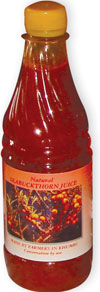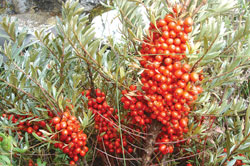|
|
DINGBOCHE-Birds, mice and Chinese herbalists have long understood the health benefits of sea-buckthorn berries, but now farmers in Solu Khumbu are looking to make money from these tart-tasting fruit.
At Dingboche, in the shadow of Ama Dablam, the Khumbu Alpine Conservation Council has been teaching villagers to make a healthy juice from the wild berries, which they can sell to thirsty tourists heading for Everest Base Camp or transport to Kathmandu\'s cafes and bars for the cocktail crowd. The council has given priority to those villagers, particularly women, who do not own tourist lodges or camp-sites and need an alternative source of income.
The common sea-buckthorn, known locally as akhrilo, grows close to the trekking trails in Sagarmatha National Park, making it easy to collect and process the orange berries. Local farmers have used it to control erosion as it grows well in the thin, dry soils and can survive the icy Himalayan winter. But until recently, few in Nepal had bothered to seek other uses for it.
The juice contains on average about 12 times more vitamin C than orange juice, and research during the past 30 years in other parts of the world has found that oils in the juice and seeds contain high levels of antioxidants which may help prevent cancer and other diseases.
For centuries, Chinese herbalists have used the berry juice, leaves and bark to treat a wide range of ailments, including indigestion, diarrhoea, coughs, ulcers and blood disorders. The fruits are also known to have anti-inflammatory properties and are a rich source of vitamin E, minerals and carotenoids which provide vitamin A. In some countries people use the flowers to soften their skin.
 The berries are unpleasant to eat raw because of their very bitter taste, but entrepreneurs in some north-western Himalayan districts, including Manang and Mustang, have found ways to use the plant to make juice, jams and pickles, with funding and technical advice from development agencies. Tourists trekking round Annapurna can find sea-buckthorn juice listed on the menu at lodges along the route.
The berries are unpleasant to eat raw because of their very bitter taste, but entrepreneurs in some north-western Himalayan districts, including Manang and Mustang, have found ways to use the plant to make juice, jams and pickles, with funding and technical advice from development agencies. Tourists trekking round Annapurna can find sea-buckthorn juice listed on the menu at lodges along the route.
The common sea-buckthorn grows throughout the high mountain areas of Nepal all the way from Humla in the far north-west to Taplejung in the east.
"The fruit has it has great potential to boost the incomes of farmers who previously depended almost solely on growing potatoes and barley," says Ang Rita Sherpa of the Mountain Institute. Unusually, the raw juice only freezes at temperatures lower than minus-20 degrees Celsius, so there is no problem with it freezing up in winter.
Beyond Nepal, common sea-buckthorn grows mainly in China, where farmers admire its ability to survive in dry, semi-desert conditions and plant it to help reduce soil erosion.
In Dingboche, after just a few days of training from the conservation council, the farmers have learnt how to add water, sugar and preservative to the raw juice, and cook the mixture to make it both palatable and healthy. All they need now is for some adventurous, thirsty trekkers to stop off on their way to Kala Pattar, and they\'ll be in business. Cheers!
Khumbu Alpine Conservation Council
www.mountain.org
Buckthorn on the rocks?
 Some say sea-buckthorn juice tastes like wild cherries, sour with a hint of sweetness. Others say it tastes like nothing they have had before. Rich in vitamins C and E, beta-carotene and omega-3 fatty acids, not only can the berries be used for juice but sea-buckthorn oil is valuable for reconstructive surgery and the leaves can be used for tea and herbal remedies.
Some say sea-buckthorn juice tastes like wild cherries, sour with a hint of sweetness. Others say it tastes like nothing they have had before. Rich in vitamins C and E, beta-carotene and omega-3 fatty acids, not only can the berries be used for juice but sea-buckthorn oil is valuable for reconstructive surgery and the leaves can be used for tea and herbal remedies.
Every year Bishnu Shrestha of Lotus Land Organic Farm in Bhaktapur brings in 840 bottles of sea-buckthorn juice concentrate from the mountains. He sells them at the organic market in the Summit Hotel and also distributes them to five restaurants and one department store in Kathmandu. "The demand is not that much, and it is only foreigners who buy the juice anyway," says Shrestha.
The Green Organic Caf? and Salad Bar in Thamel has been selling sea-buckthorn juice since it opened two years ago. "I have never seen a Nepali order it," says Krishna Poudel at the caf?.
The juice that the Lotus Land Organic Farm brings to Kathmandu is processed and packed in recycled beer bottles in Mustang by a community who received training in juice processing from the Danish aid agency, Danida. Each bottle is priced at Rs 175, but Shrestha says there isn't much profit in the business.
"Porters have to carry the juice from Jomsom to Pokhara and then bring it to Kathmandu," says Shrestha. "The cost of transportation alone comes to more than Rs 70."
The cafe hasn't tried to experiment with the juice yet, but Poudel says it should. "If we make exotic sea-buckthorn cocktails, we can probably sell more."
Mallika Aryal



